Apartments can face a small number of bugs at any moment. Some of these bugs are nuisance pests while others can spread bacteria and viruses.
Identifying the bugs most likely to be found in apartments helps prevent them and deal with them correctly in case you spot them indoors.
Table of Contents
How do Bugs Get in Your Apartment?
Most bugs are carried in apartments when carried indoors. They can also fly indoors when through open windows.
- Carried by pets and humans – people carry bugs from nature or homes or public spaces infested by bugs.
- Making their way through gaps and cracks – bugs make their way through cracks in walls or openings around door and window frames.
- Plants – potted plants may carry different bugs such as stink bugs and mites indoors.
- Doors and windows – open windows attract flies and mosquitoes indoors.
Common Bugs Found in Apartments
The following species of bugs are the most likely to be found in apartments.
1. Bed Bugs
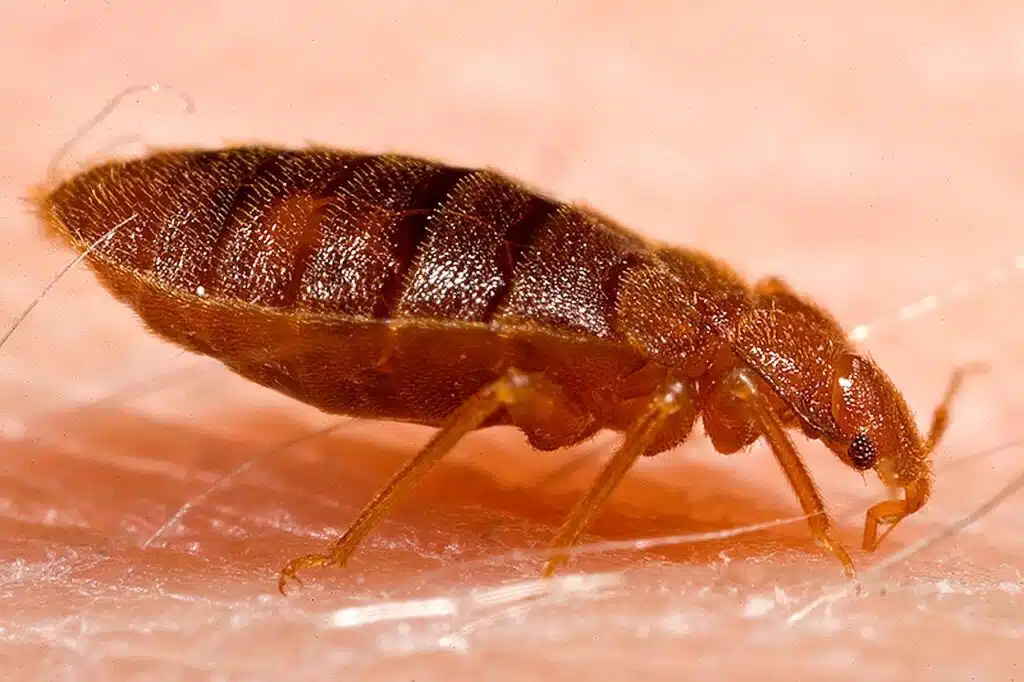
Some of the most common types of bugs in apartments are bed bugs. These types of bugs get into apartments on luggage, clothes, or pets.
You can find bed bugs are easily transferable from hotels or college dorms to your apartment.
One of the biggest issues when it comes to these bugs is that some of them can survive a long time without a blood meal.
These biting bugs have sometimes survived months without a blood meal which means they need to be taken seriously and eliminated from homes immediately.
Bed bugs are nocturnal and they’re some of the best at hiding during the day.
They might hide under the bed but some go deeper crawling under wallpaper or behind mirrors or paintings on walls in places of complete darkness away from sight.
What do beg bugs eat?
Bed bugs attach themselves to hosts. They drink blood from animals, pets, and even humans.
A bed bug may bite or feed up to 10 times per night. This means a single bug can bite a few times until full.
These bugs are resilient and they can survive poor control attempts such as raising room temperature. Bed bugs survive up to 120 degrees Fahrenheit.
How do I know the bugs in my apartment are bed bugs?
Analyzing the size, shape, and color of the bug will determine a bed bug species. Bed bugs are shaped similarly to apple seeds.
They have dark red to brown coloring and shiny wingless bodies.
Looking at the bites on the skin can also help identify bed bugs even without spotting them. The bite marks can be seen in clusters over a short area of the body or in lines
2. Cockroaches
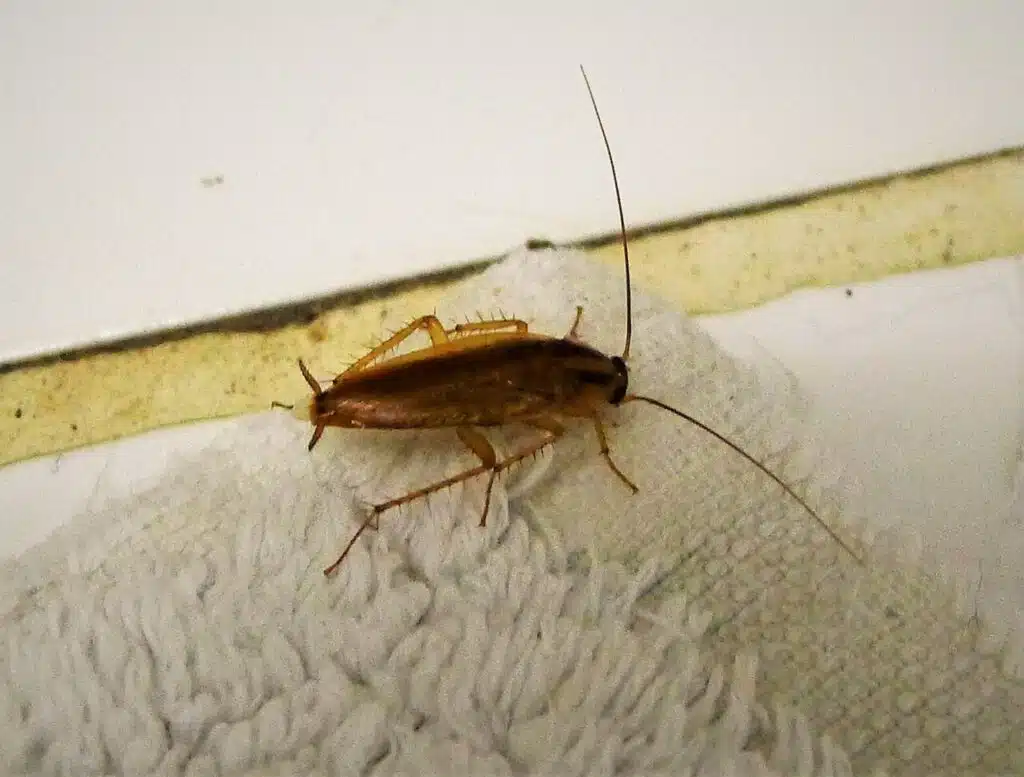
Some of the most common bugs in apartments are cockroaches. These types of bugs live almost anywhere humans live as well.
German cockroaches, oriental cockroaches, and American cockroaches are some of the most visible roach species around the world.
These roaches like to live in gardens, in mulch, and around homes, as there’s plenty of food, warmth, moisture, and organic materials to feed on.
Cockroaches may be a problem in apartments in high numbers as exterminators might be needed to get rid of them. A small number of spotted roaches can usually be eliminated without the help of a professional.
Removing all foods and checking all element roaches such as high humidity is essential to get rid of them quickly.
What do cockroaches eat?
Most cockroaches eat leftover food, crumbles on the floor, garbage, decaying food, and even other types of non-food items such as paper and cardboard.
Eliminating all open foods and clearing the kitchen and the house of all foods is eventually going to make roaches starve, die, or move elsewhere.
Water leaks under sinks and bathtubs also attract cockroaches as they love humidity. Fixing all water leaks and entryways to the house is also a must to keep roaches out.
How do I know the bugs in my apartment are cockroaches?
Cockroaches might grow to a size larger than 1 inch and come in brown or black colors. They have spiny legs and long antennae and can crawl fast. Cockroaches can’t fly or are very poor at flying.
You can also identify cockroaches in apartments by their hiding spots, which are crawl spaces under cupboards or refrigerators.
3. Spiders
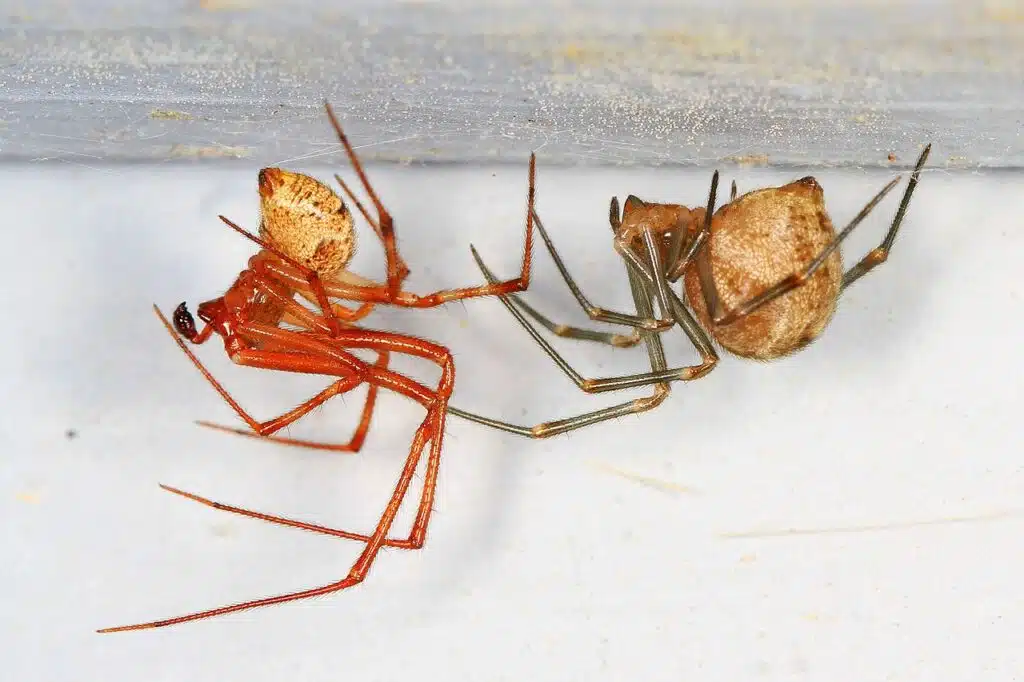
Almost all apartments have spiders in them at one point. Arachnids such as spiders get in the house from nearby vegetation or carried on clothes, luggage, food, or other items.
Most indoor spiders don’t bite and aren’t dangerous, preferring to flee when seeing humans.
Other types of spiders may bite if handled. Eliminating them from apartments mostly involves regular cleaning routines.
Spiders can get indoors attracted to light or by moving through wall cracks or openings around doors and windows.
Sealing entry points is also vital to eliminate them.
What do spiders eat?
Spiders eat insects, insect eggs, and even other spiders. Spiders that build spider webs can only catch insects by first building a spider web, typically in the lower or upper corners of a room.
Jumping spiders catch insects by pouncing on them as they don’t build spider webs.
Both web-weaving and jumping spiders can sometimes bite humans.
Unlike roaches, the spider shouldn’t be handled by hand if you aren’t sure the species in your home are non-biting and non-venomous.
Vacuum cleaning and sweeping is one of the ideal ways to eliminate them from an apartment.
How do I know the bugs in my apartment are spiders?
Spiders are shiny or hairy creatures with 8 legs, without wings, and without antennae.
They have a front section of the body connected to a back or abdomen section.
Most spiders have 8 eyes of varying sizes and are arranged in different types of grouping.
4. Ants
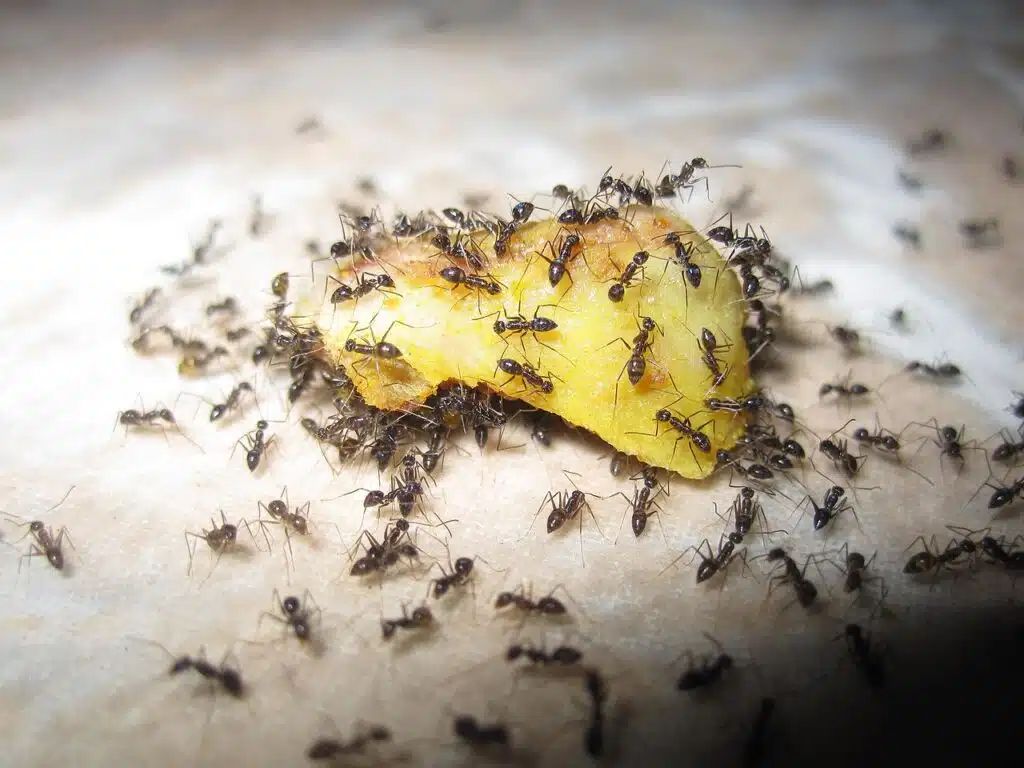
Sweet foods with plenty of sugar are the main reasons ants are found in your apartment. Pure sugar attracts ants, but so do fruits and bread, which also have sugar in them.
Apartments on ground floors are typically the most exposed as many ants make their way from nearby nests in the house.
Various species of ants may appear together in the first days of spring, looking for food.
Ants will die in an apartment where they cannot find food on the table, on the floor, or food traces under cupboards or around trash cans.
Unlike bed bugs which can survive a very long time without food, most ants die within 2 weeks if they cannot find any food.
On the other hand, ants start to reproduce and nest in apartments they can find food.
They can also contaminate the food you leave out in the open.
What do ants eat?
Ants can eat sweet foods and sweet food traces. They can also feed on juice spills and fruit juices on the floor or around the house.
Ants can also be carnivores and feed on insects, but not to the same extent as spiders.
Sweet plants in the house might be one of the overlooked foods for apartments with ant invasions you need to eliminate.
How do I know the bugs in my apartment are ants?
You can identify ants by size, color, and shape.
Most ants measure anywhere between 5 and 15mm and can be some of the smallest invasive species.
They have a red, brown, black, and yellow coloring, depending on their age, cast, and species.
Ants have 6 legs or 3 pairs of legs which they use to crawl. They are only occasional flyers as they rely on scent traces to mark routes between food sources and their nest.
5. Mosquitoes
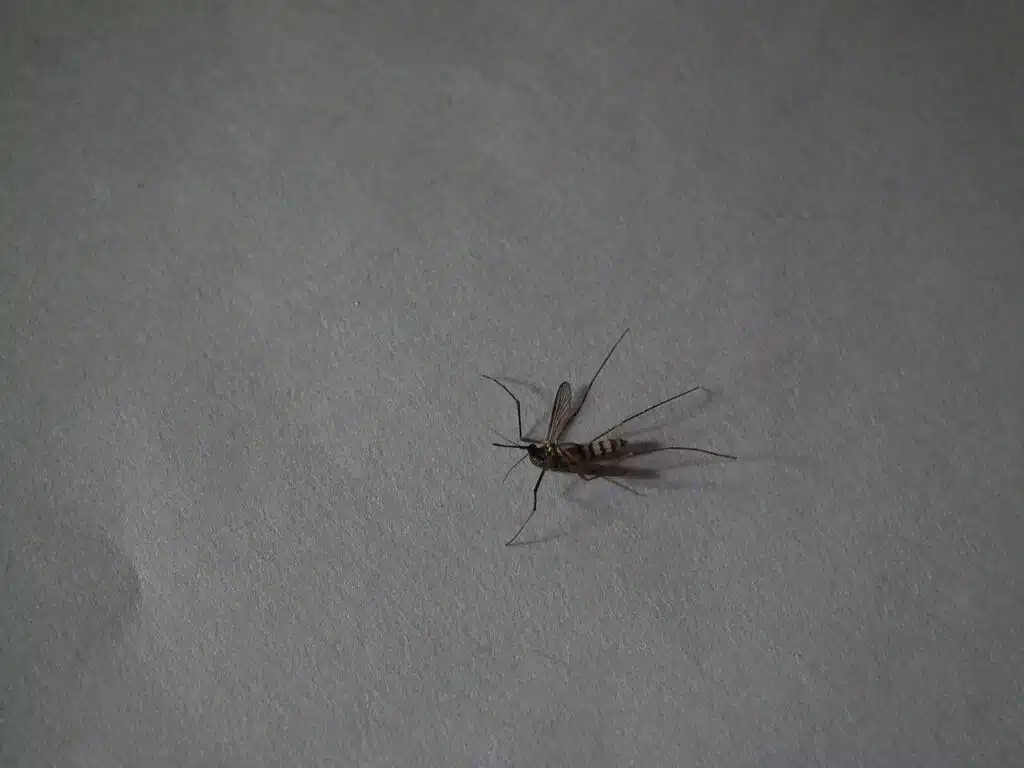
Mosquitoes are a frequent problem in apartments. They fly in through open windows or doors attracted to light almost immediately at night.
All mosquitoes need food and water to survive. Temporary or permanent bodies of water are ideal breeding grounds for mosquitoes to lay eggs in.
Once hatches, mosquitoes move for a blood meal from animals or humans.
Apartments without protective window mesh screens can see a high number of mosquitoes. Occasional bites mean mosquitoes can survive and even breed inside the apartment.
Preventive measures against mosquitoes include lowering humidity, installing mesh screens, and looking for plants such as lavender to purchase and add around the apartment as they repel these biting insects.
What do mosquitoes eat?
Flower nectar is one of the preferred foods for mosquitoes. Females also drink blood as they need a blood meal to lay eggs.
Some mosquitoes can also eat honeydew, a plant residue left behind by feeding aphids.
You may be inviting mosquitoes to your apartment when you have potted plants invaded by aphids.
Female mosquitoes have adapted mouthparts they use to pierce plants as well as human and animal skin for blood.
How do I know the bugs in my apartment are mosquitoes?
Mosquitoes have a gray or brown color, long legs, and elongated mouthparts used for sucking plant sap and blood.
They have a size of up to 0.14 inches and long wings they use to fly as opposed to crawling insects.
Some mosquitoes can be much smaller, being a bit more difficult to spot. Mosquitoes make a flying sound or a buzzing sound due to rapid wing flapping which means most can be heard.
6. Flies
Some of the most annoying insects in apartments are flies. They seem to come out of nowhere and they can be very difficult to eliminate as they multiply rapidly.
The common housefly is one of the typical species of flies you can find in apartments. Drain flies are at least as common in homes as well.
Flies come from almost anywhere outdoors and fly indoors either attracted to light or food.
They stay indoors as they can find food such as fruits, meat, and almost any other type of decaying food or organic materials buildup.
Drain flies live in drains where they lay eggs on organic materials buildup from foods on dishes.
Only some flies bite but many can transmit viruses and diseases. Contaminated food is one of the common ways in which viruses are transmitted through flies.
Flies land on open food you later eat ingesting bacteria carried by the species.
What do flies eat?
Fruit and vegetables are among the first types of food flies eat. They can eat small amounts of fresh fruit or small amounts of rotting fruit as well as different meats.
Dead animals and other dead insects are also on the food list for flies.
Human and animal feces are also eaten by flies which make them disease-spread vectors.
How do I know the bugs in my apartment are flies?
A typical fly in the apartment has a black body or a gray body in a size of up to a quarter inch. Flies have short hairs covering their body and 2 transparent wings.
You can also identify flies by their good flying abilities and by their presence on almost any type of food.
7. Carpet Beetles
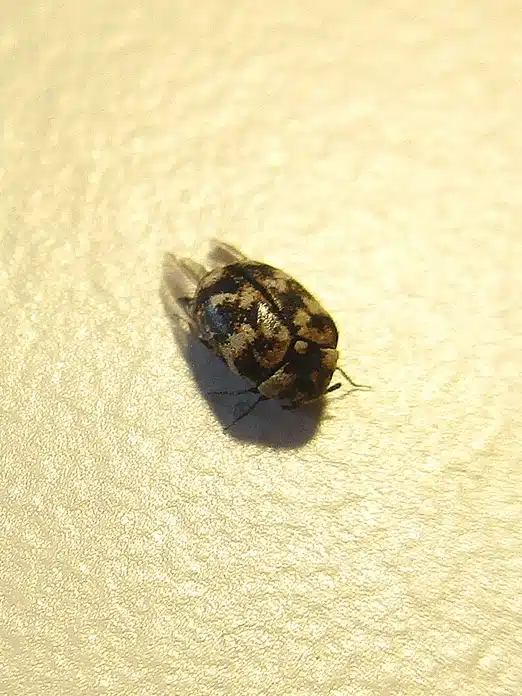
Carpet beetles are some of the smallest types of fuzzy bugs in apartments. They can live even in the cleanest apartments as they can make their way indoors on hair, luggage, or clothes.
A large number of invaded homes have poor cleaning routines, on the other hand. Rarely vacuuming and cleaning the home allows carpet beetles to multiply in high numbers.
Some of the places carpet beetles can be found includes carpets, pillows, blankets, clothes, towels, and other textiles.
At their core, carpet beetles only feed on plants as they live outdoors and thrive on plant pollen. Their diet is adaptable when making it indoors.
What do carpet beetles eat?
Adult carpet beetles feed on plant pollen. They have a different diet indoors where they cannot find plants to feed on.
They can eat almost any type of clothes or carpets made from wool or other natural fibers.
Human skin is also a common food for these beetles together with wool and fur.
Carpet beetles can survive a long time in apartments. They don’t bite and can be eliminated by vacuuming and deep cleaning the home.
How do I know the bugs in my apartment are carpet beetles?
Carpet beetles are small, round bugs, that are mostly brown, yellow, and white. They can also have a brown-dominating color into adulthood.
These bugs are covered in short hairs.
8. Fleas
Fleas are one of the biting species that can make their way into apartments. Sometimes too small to spot with the naked eye, this is a biting species that can transmit disease through blood.
Fleas rarely move indoors on their own, attracted to heat, or attracted to light.
They are mostly attached to a host which means they need humans or animals for a blood meal.
Most fleas get into apartments on pets. You can find them jumping on your dog or on the area the dog sleeps in.
What do fleas eat?
Fleas feed on fresh blood they take from animals such as rodents or pets and even humans.
Immature nymphs feed on blood-rich excrements of adult fleas. Without blood, fleas eventually die and cannot survive in apartments.
How do I know the bugs in my apartment are fleas?
A jumping method of movement is the first clue the bugs in your apartment are fleas. These bugs can jump long distances even longer than their body size.
Fleas have a red-brown color with a darker nuance after feeding as blood colors their body.
9. Lice
Lice are another type of bug that needs a host, just like fleas. They feed on blood and they bite humans.
A smaller amount of blood is consumed by lice as compared to other types of biting insects such as mosquitoes.
Still, these bites are itchy and they need concrete management action to be eliminated.
Direct contact with other humans that already have lice is one of the most common methods of carrying lice back to your home.
Lice can only survive on a human host, typically hiding between hair follicles where they also lay eggs.
What do lice eat?
Lice eat blood. They need blood to reproduce and survive.
A small amount of blood is consumed frequently by these bugs until they are removed from the body area they are found in.
Lice on the head are known as head lice. These can be removed with special shampoos or by cutting the hair.
How do I know the bugs in my apartment are lice?
Lice are small bugs with 6 legs. They come in gray or white coloring and are mostly found on the head or in pubic hair.
They are carried in homes from public places such as playgrounds and hotels or through direct contact with a person that already has lice.
10. House Centipedes
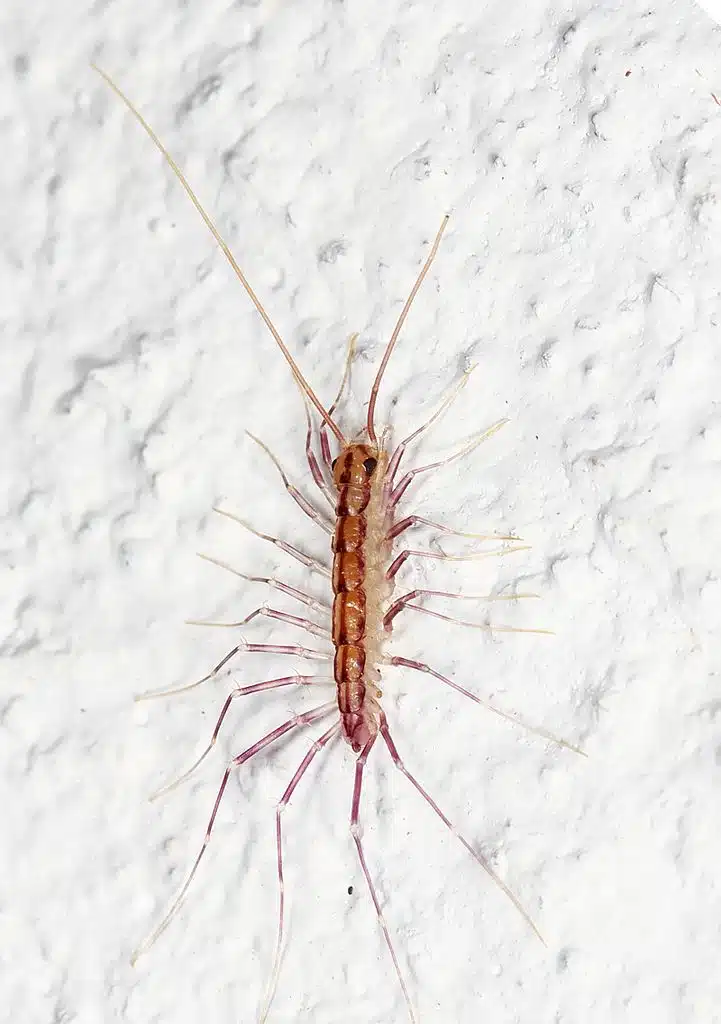
House centipedes are among the bugs with the most legs that you may find in an apartment.
Rarely seen as a single bug in a house, this species is mostly attracted to bugs you already have in the apartment as they are predators.
They don’t stay indoors if they cannot find roaches, insects, or other bugs to feed on.
As a result, one of the house centipedes management techniques includes eliminating all bugs from the house by deep cleaning.
What do house centipedes eat?
House centipedes eat spiders, flies, roaches, bed bugs, and other types of bugs they can find either outdoors or indoors.
In many cases, house centipedes are the species that are seen as beneficial bugs in the house as they eat and help reduce the population of pests.
How do I know the bugs in my apartment are house centipedes?
A species with gray-yellow coloring, house centipedes are identified by their elongated body with multiple pairs of legs.
House centipedes have 15 pairs of legs along their body, making them look different from other species of bugs with 3 pairs of legs mostly seen indoors.
11. Crickets
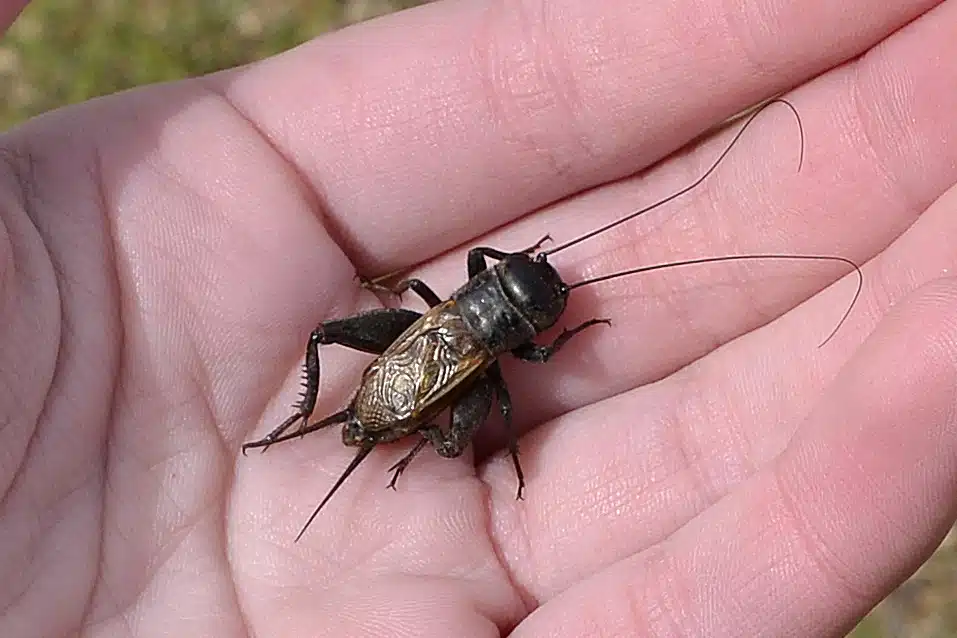
There are many types of crickets around the world. Common house crickets are among the species most notably found in apartments.
Moisture is the primary reason this species might be interested in your apartment and in staying there as well.
As with other bugs, crickets seek out a moist place that is also dark. They might share the space under furniture or the sink with roaches and other types of bugs.
What do crickets eat?
Apart from moisture, crickets also need food to survive. They are omnivores and eat other insects, larvae, fruits, and various soft plants.
These types of foods are found in apartments with potted plants and with other types of pests around.
How do I know the bugs in my apartment are crickets?
You can identify house crickets by their yellow or cream-yellow color with black crossbands on the head.
Crickets also come in many other colors and color combinations. Plain green and plain black crickets are also common in homes, mainly by accident.
12. Scorpions
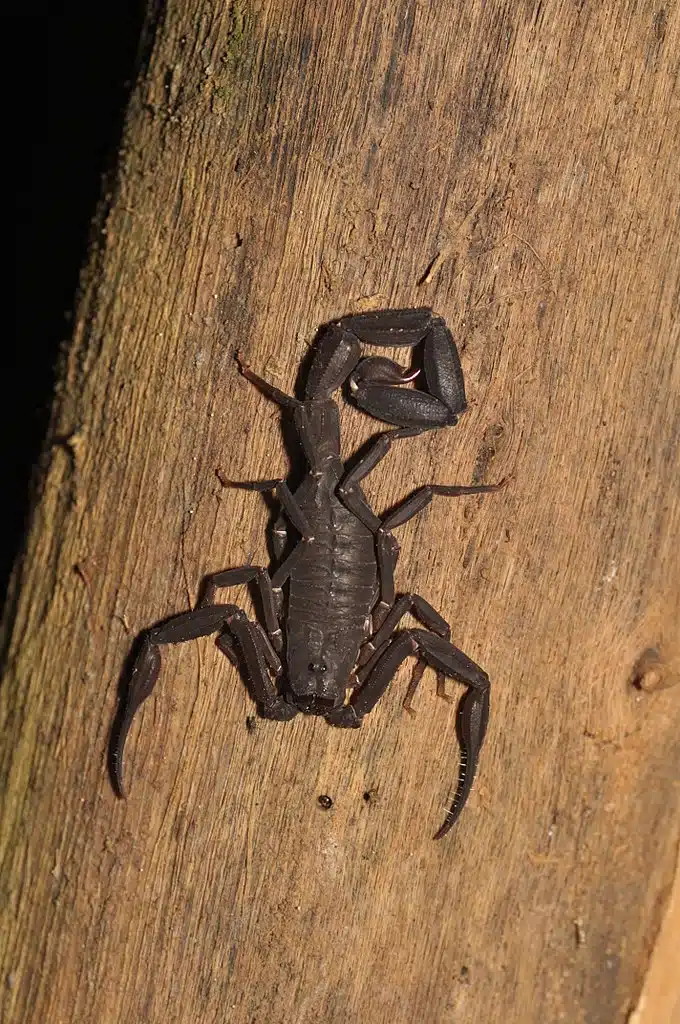
Scorpions live on all continents in areas with plenty of heat. They are found around Arizona, New Mexico, and California in the Southwestern parts of the United States.
Scorpions move indoors looking for food. They can only make their way into the house when they find gaps under doors or around windows they can take advantage of.
Scorpions are venomous and dangerous and they should not be handled with bare heads or directly with the hands as they can sting.
What do scorpions eat?
Scorpions like to eat insects and arachnids. Spiders are one of the main reasons scorpions might be around the apartment for more than a few hours.
Eliminating food sources and sealing all gaps in and around walls is mandatory to keep scorpions out if you live in an area around the world where there are scorpions.
How do I know the bugs in my apartment are scorpions?
Scorpions have a thin elongated body that is separated into small segments. They come in different colors such as in black or tan colors and they have long front pincers and a stinging tail.
13. Termites
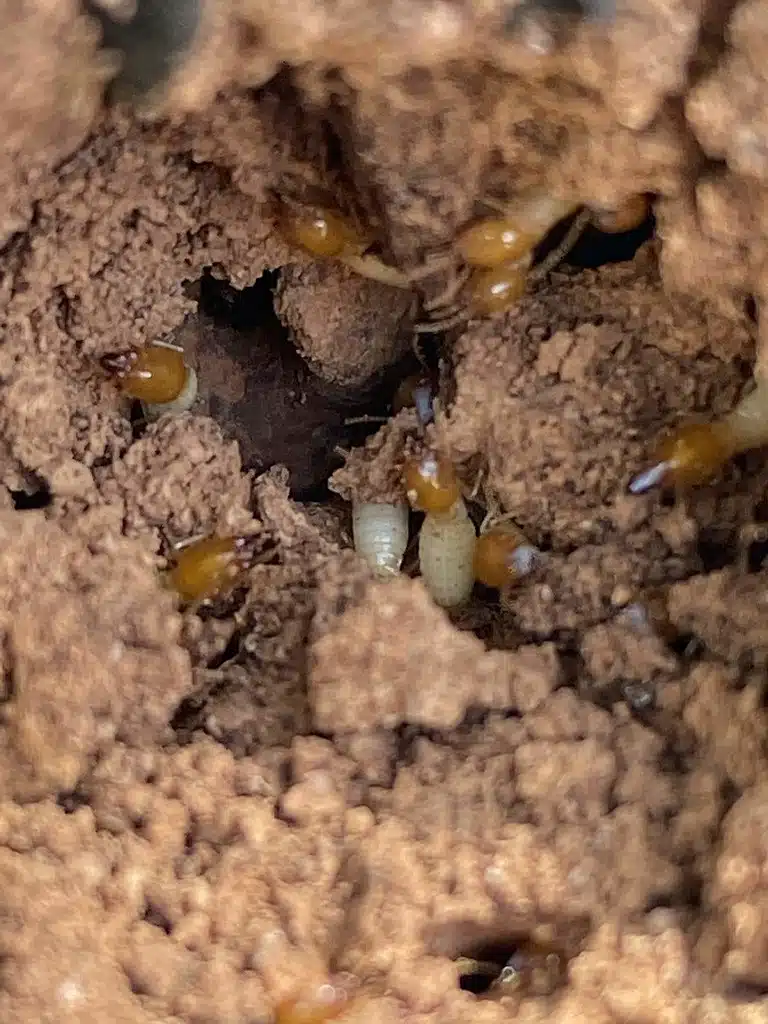
Termites are never a good sign in an apartment. They signal structural problems in wooden walls and they can be troublesome to houses impacted by high humidity.
Decaying wood or wood that has been in contact with water for a prolonged period in an apartment located in one of North America’s termite areas is prone to this problem.
You can rarely deal with termites alone as you need to call an exterminator. Even plumbers might join the termite elimination process as these bugs are attracted to leak-caused humidity issues.
What do termites eat?
Cellulose from wood and paper is the primary food for termites. These types of bugs aren’t interested in bread, sugar, or other organic materials in the house.
How do I know the bugs in my apartment are termites?
Termites have a small body that measures a maximum of 0.5 inches. They have an elongated shape and can be brown, tan, or black.
Wings are often found separately as termites shed their wings once they fly indoors, typically once per season.
14. Silverfish
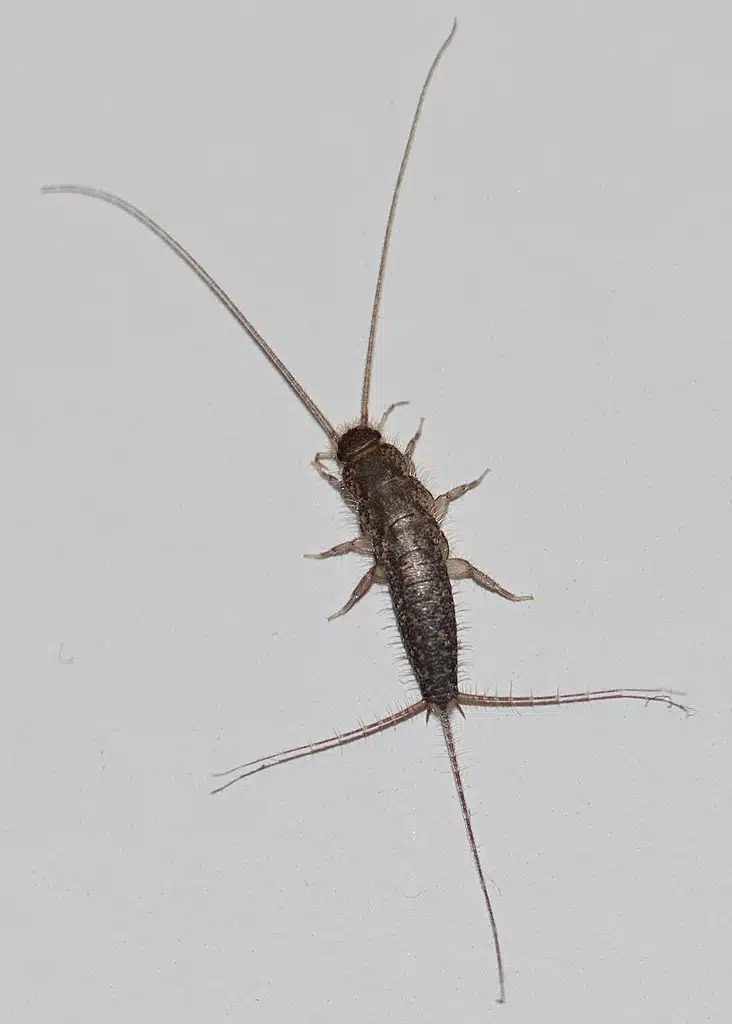
Like other bugs in apartments, silverfish are mostly attracted to food or moisture. Areas around the sink and hiding spots in bathrooms are some of the most common places silverfish are found around the house.
Silverfish can only survive in areas of high humidity in the house. One of the common methods of keeping these bugs out is by lowering humidity levels, typically with a dehumidifier.
What do silverfish eat?
Silverfish are one of the bugs that eat almost anything they can find indoors.
From protein to carbohydrates and from paper to towels, these bugs can chew their way through foods and materials.
How do I know the bugs in my apartment are silverfish?
Silverfish have an elongated body that narrows at the end. They have a gray to blue color with long antennae.
These bugs are larger than others, measuring anywhere between 0.5 and 1 inch.
15. Earwigs
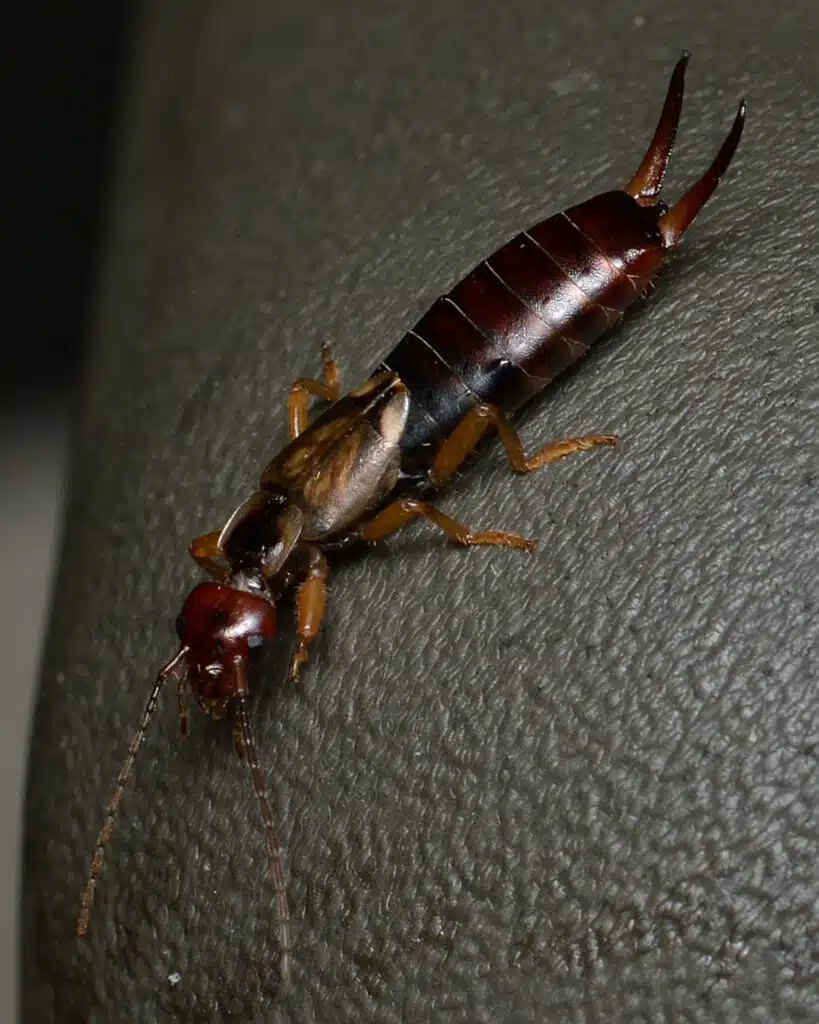
Earwigs are some of the types of bugs you can bring indoors with plants or on your clothes.
A hiking trip or a camping trip might serve as the vector for carrying these bugs indoors.
Earwigs can survive indoors as they have a varied diet.
What do earwigs eat?
Plants, fruit, insects, and legumes are among the types of food earwigs can eat. Almost all of them can be found indoors. Earwigs prefer plants as they can hide in the moist soil of potted flowers indoors.
How do I know the bugs in my apartment are earwigs?
You can identify earwigs by their long body with elongated pincers.
These forceps can be elevated as the species approaches insects it plans to grab and eat.
Earwigs come in varying sizes but they rarely measure more than 15-16mm.
16. Mites
Mites are some of the smallest types of bugs in apartments. They are rarely seen but microscope analysis can confirm their presence.
Mold mites are a type of bug that’s present in apartments affected by mold. Together with mold itself, these types of bugs can lead to various respiratory issues.
What do mites eat?
Mold mites eat the type of organic material they attach themselves to. Mold mites eat mold and mildew and are exclusively found in the areas of the house with mold formation.
How do I know the bugs in my apartment are mites?
Mites are small bugs that measure around 5-6mm. They look similar to spiders being mostly white but rarely visible due to their reduced size.
17. Stink Bugs
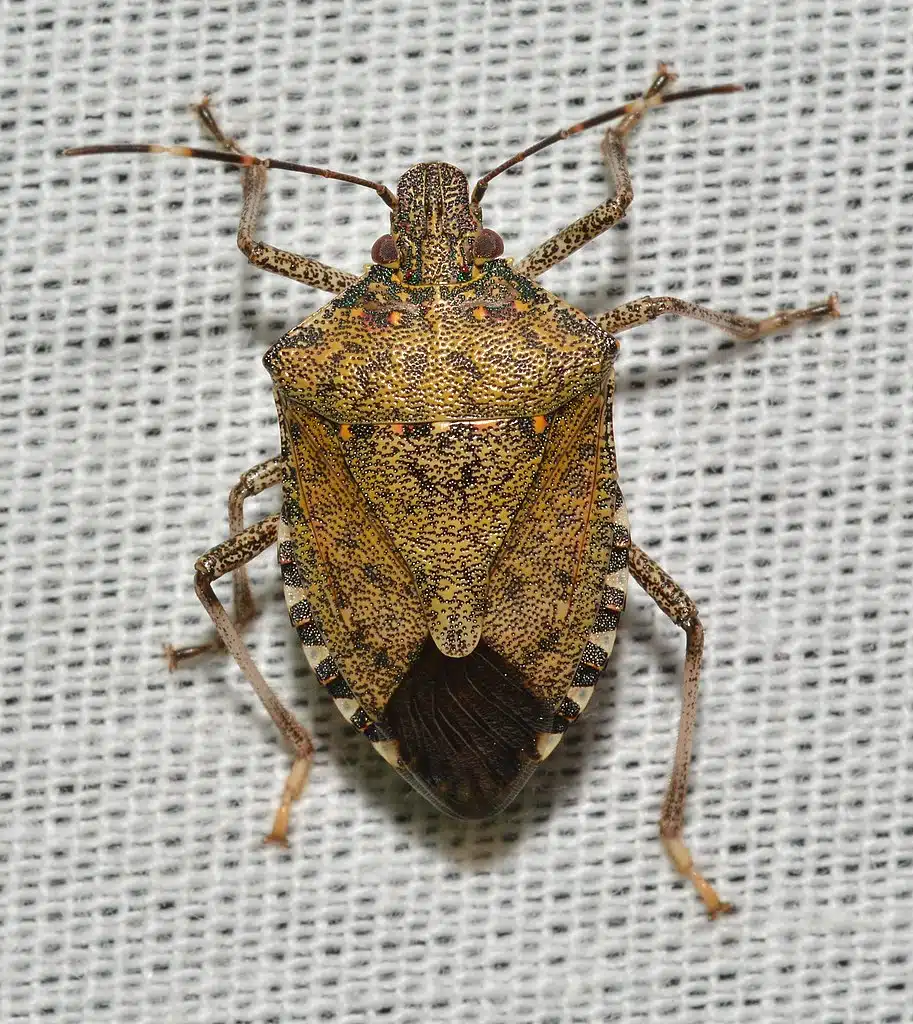
One of the bugs making its way indoors for warmth is the stink bug. Known for its many species, this is a bug named after its repelling smell.
Stink bugs release a bad smell when handled or threatened.
What do stink bugs eat?
Stink bugs eat the leaves and flowers of some of your house plants. They might survive and multiply in homes with multiple house plants.
How do I know the bugs in my apartment are stink bugs?
A shield-like shape and gray-to-brown coloring are specific to many species of stink bugs.
Further species confirmation is possible by tracking their movements as stink bugs can fly and are generally good fliers.
How to Get Rid of Bugs in Apartment?
Eliminated bugs confirmed in the apartment are typically based on cleaning management techniques. Exceptions apply to termites and other similar species which require the help of an exterminator.
- Use a vacuum cleaner
A vacuum cleaner can be used to vacuum all bugs and flies around the apartment. The dust bag can then be sealed in a zip-locked plastic bag and discarded at the trash can.
- Vacuum all common areas and hard-to-reach areas
Vacuuming needs to be thorough as bugs are very good at escaping and crawling under furniture to hide from humans. You need to move furniture to access all difficult areas to vacuum.
How to Prevent Bugs in Apartments
Preventive measures typically include sealing all gaps around doors and windows or installing mesh screens on windows. Here are other techniques to consider to keep bugs out of the apartment.
- Check plants for bugs
You can check all plants you bring indoors for bugs. Most bugs like fresh or decaying plants and they can attach themselves to potted plants you purchase to decorate the apartment with.
- Set a routine cleaning schedule
Proper vacuuming and dusting eliminate the risk of having bugs such as spiders or dust mites in the apartment.
Frequently vacuuming even hard-to-reach areas such as the gap between floors and the bathtub is required to eliminate moist-loving bugs.
- Avoid contact with infested homes, people, or pets
Some species such as fleas and lice are transmitted through humans, pets, and animals. You should avoid sleeping on a hotel bed you’ve confirmed bed bug on, for example. You can carry all of these bugs from people or places already infested by them to your apartment.